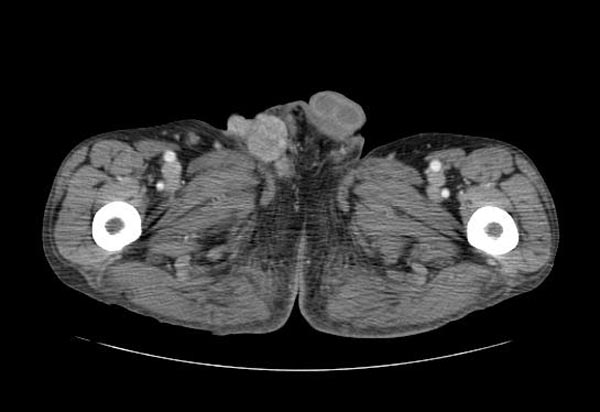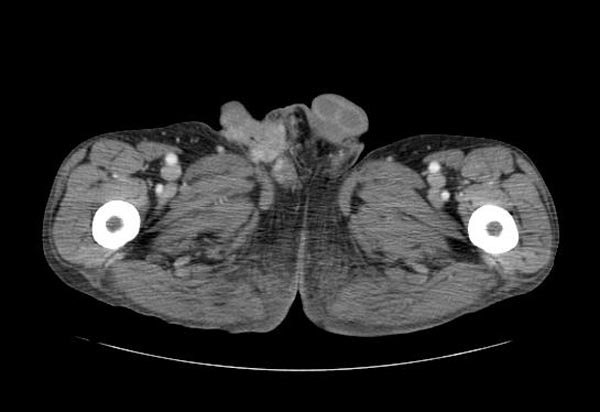Dermatofibrosarcoma protuberans
Editor-In-Chief: C. Michael Gibson, M.S., M.D. [1];Associate Editor(s)-in-Chief: Kiran Singh, M.D. [2], Faizan Sheraz, M.D. [3]
Synonyms and keywords:: Darier-Ferrand tumor, Darier-Hoffmann tumor, dermatofibrosarcoma, DFSP
Overview
Dermatofibrosarcoma protuberans (DFSP) is a rare neoplasm of the dermis layer of the skin, and is classified as a sarcoma. In many respects, the disease behaves as a benign tumor, but in 2-5% of cases it can metastasize, so it should be considered to have malignant potential.
Over 95% of DFSP tumors have the chromosomal translocation t(17;22). The translocation fuses the collagen gene (COL1A1) with the platelet-derived growth factor gene. The fibroblast, the cell of origin of this tumor, expresses the fusion gene in the belief that it is collagen. However the resulting fusion protein is processed into mature platelet-derived growth factor which is a potent growth factor. Fibroblasts contain the receptor for this growth factor. Thus the cell "thinks" it is producing a structural protein, but in fact produces a self-stimulatory growth signal. The cell divides rapidly and a tumor forms. In dermatofibrosarcoma protuberans, the tumor has a tendency to return after being removed. However, it does not often metastasize to other parts of the body.
Pathophysiology
Dermatofibrosarcoma protuberans is associated with a rearrangement (translocation) of genetic material between chromosomes 17 and 22. This translocation, written as t(17;22), fuses part of the COL1A1 gene from chromosome 17 with part of the PDGFB gene from chromosome 22. The translocation is found on one or more extra chromosomes that can be either the normal linear shape or circular. When circular, the extra chromosomes are known as supernumerary ring chromosomes. Ring chromosomes occur when a chromosome breaks in two places and the ends of the chromosome arms fuse together to form a circular structure. Other genes from chromosomes 17 and 22 can be found on the extra chromosomes, but the role these genes play in development of the condition is unclear. The translocation is acquired during a person's lifetime and the chromosomes containing the translocation are present only in the tumor cells. This type of genetic change is called a somatic mutation. In normal cells, the COL1A1 gene provides instructions for making part of a large molecule called type I collagen, which strengthens and supports many tissues in the body. The PDGFB gene provides instructions for making one version (isoform) of the platelet derived growth factor (PDGF) protein. By attaching to its receptor, the active PDGFB protein stimulates many cellular processes, including cell growth and division (proliferation) and maturation (differentiation). The abnormally fused COL1A1-PDGFB gene provides instructions for making an abnormal combined (fusion) protein that researchers believe ultimately functions like the PDGFB protein. The gene fusion leads to the production of an excessive amount of protein that functions like the PDGFB protein. In excess, this fusion protein stimulates cells to proliferate and differentiate abnormally, leading to the tumor formation seen in dermatofibrosarcoma protuberans. The COL1A1-PDGFB fusion gene is found in more than 90 percent of dermatofibrosarcoma protuberans cases. In the remaining cases, changes in other genes may be associated with this condition. These genes have not been identified[1].
Classification
There are several variants of dermatofibrosarcoma protuberans in which different cell types are involved in the tumor. Bednar tumors, often called pigmented dermatofibrosarcoma protuberans, contain dark-colored (pigmented) cells called melanin-containing dendritic cells. Myxoid dermatofibrosarcoma protuberans tumors contain an abnormal type of connective tissue known as myxoid stroma. Giant cell fibroblastoma, which is sometimes referred to as juvenile dermatofibrosarcoma protuberans because it typically affects children and adolescents, is characterized by giant cells in the tumor.
Epidemiology and Demographics
Dermatofibrosarcoma protuberans is estimated to occur in 1 in 100,000 to 1 in 1 million people per year.
Differential Diagnosis
Dermatofibrosarcoma protuberans must be differentiated from dermatofibroma and fibrosarcomatous dermatofibrosarcoma protuberans.
History and Symptoms
Tumors are most commonly found on the torso and can also be found on the arms, legs, head, or neck.
Physical Examination
In dermatofibrosarcoma protuberans, the tumor most often starts as a small, firm patch of skin, usually 1 to 5 centimeters in diameter, that is usually purplish, reddish, or flesh-colored. The tumor typically grows slowly and can become a raised nodule. Occasionally, the tumor begins as a flat or depressed patch of skin (plaque).
Treatment
Treatment is primarily surgical, with chemotherapy and radiation therapy sometimes being used.
There is clinical evidence that imatinib, which inhibits PDGFB, may be effective for tumors positive for the t(17;22) translocation.
CT images demonstrating a dermatofibrosarcoma protuberans in the right groin
Diagnosis
Physical Examination
Skin
Extremities
-
Dermatofibrosarcoma protuberans. Adapted from Dermatology Atlas.[2]
-
Dermatofibrosarcoma protuberans. Adapted from Dermatology Atlas.[2]
-
Dermatofibrosarcoma protuberans. Adapted from Dermatology Atlas.[2]
-
Dermatofibrosarcoma protuberans. Adapted from Dermatology Atlas.[2]
-
Dermatofibrosarcoma protuberans. Adapted from Dermatology Atlas.[2]
Trunk
-
Dermatofibrosarcoma protuberans. Adapted from Dermatology Atlas.[2]
-
Dermatofibrosarcoma protuberans. Adapted from Dermatology Atlas.[2]
-
Dermatofibrosarcoma protuberans. Adapted from Dermatology Atlas.[2]
-
Dermatofibrosarcoma protuberans. Adapted from Dermatology Atlas.[2]
-
Dermatofibrosarcoma protuberans. Adapted from Dermatology Atlas.[2]



![Dermatofibrosarcoma protuberans. Adapted from Dermatology Atlas.[2]](/images/b/b8/Dermatofibrosarcoma_protuberans01.jpg)
![Dermatofibrosarcoma protuberans. Adapted from Dermatology Atlas.[2]](/images/a/a5/Dermatofibrosarcoma_protuberans02.jpg)
![Dermatofibrosarcoma protuberans. Adapted from Dermatology Atlas.[2]](/images/0/01/Dermatofibrosarcoma_protuberans06.jpg)
![Dermatofibrosarcoma protuberans. Adapted from Dermatology Atlas.[2]](/images/0/00/Dermatofibrosarcoma_protuberans07.jpg)
![Dermatofibrosarcoma protuberans. Adapted from Dermatology Atlas.[2]](/images/2/22/Dermatofibrosarcoma_protuberans05.jpg)
![Dermatofibrosarcoma protuberans. Adapted from Dermatology Atlas.[2]](/images/2/2c/Dermatofibrosarcoma_protuberans03.jpg)
![Dermatofibrosarcoma protuberans. Adapted from Dermatology Atlas.[2]](/images/0/0c/Dermatofibrosarcoma_protuberans04.jpg)
![Dermatofibrosarcoma protuberans. Adapted from Dermatology Atlas.[2]](/images/9/92/Dermatofibrosarcoma_protuberans08.jpg)
![Dermatofibrosarcoma protuberans. Adapted from Dermatology Atlas.[2]](/images/a/a4/Dermatofibrosarcoma_protuberans09.jpg)
![Dermatofibrosarcoma protuberans. Adapted from Dermatology Atlas.[2]](/images/1/1b/Dermatofibrosarcoma_protuberans10.jpg)